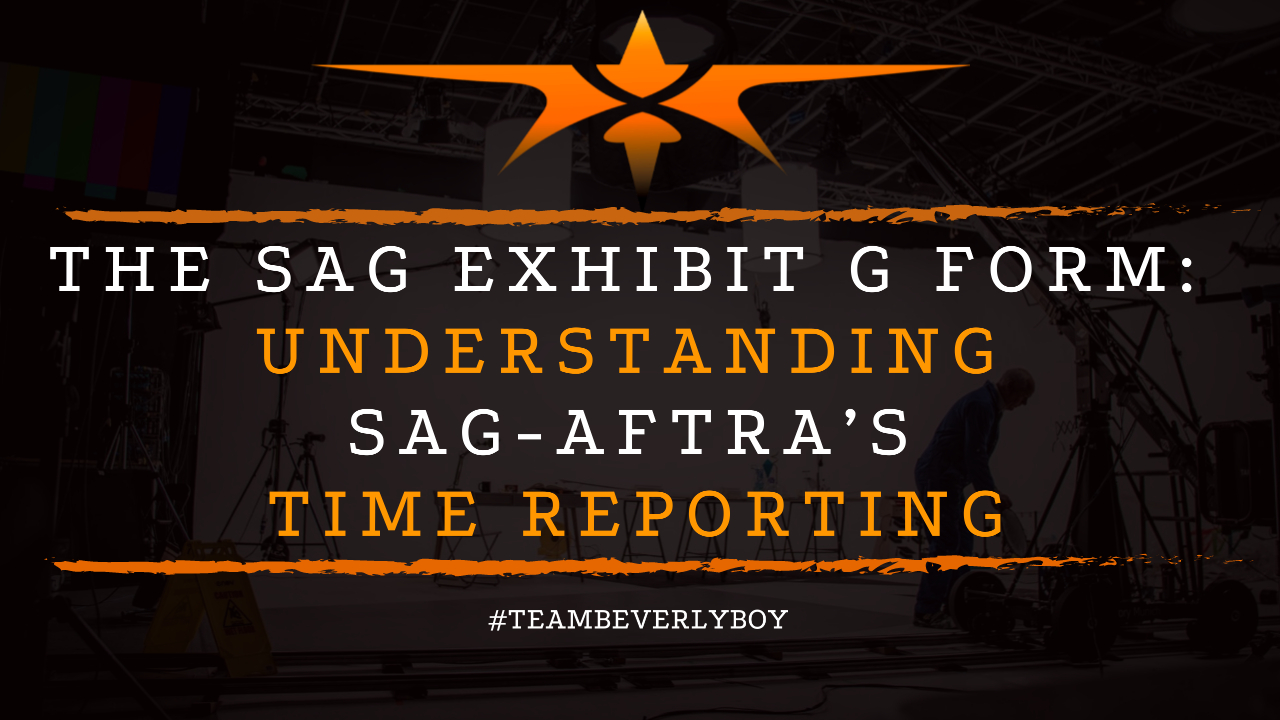
The SAG Exhibit G Form: Understanding SAG-AFTRA’s Time Reporting
Anyone that’s worked the film set for even a fraction of time knows that there’s a lot going on throughout the production at a given moment. And if you’ve ever been involved in assistant directing, you know that a lot of the time that is spent on the set consists of keeping track of the working hours and handling the official reporting requirements, especially for SAG-AFTRA members. Keeping track of and reporting the official working times for actors involved in your production can be an overwhelming process, especially if you’re new to the SAG Exhibit G Form.

Also known as the SAG-AFTRA Performers Production Time Report.
We’re going to walk you through the process of completing the SAG Exhibit G Form. So that you can spend less time worried about reporting. And more time focused on what you love!
What is the SAG Exhibit G Form?
Commonly referred to as “Exhibit G” the SAG-AFTRA Performers Production Time Report is required if your film includes the support of talent that are members of SAG-AFTRA. The report was created by the Screen Actors Guild – American Federation of Television and Radio Artists.
And it serves as the official recording document. By which filmmakers are to track the working hours for SAG actors during shoot days. This form details many important aspects of the worker’s week.
Including daily arrival time on set, dismissal times, and the actual work hours for the actor each production day. Upon completion of the SAG Exhibit G Form each day it is stored away. For the weekly communication with your SAG production representative.
At the end of the week, you will take all of your daily Exhibit G Forms. And pair them with your week’s call sheets to send over to your rep at SAG-AFTRA for review.
Why is SAG Exhibit G Form Required?
You might be thinking, can’t I just use the same reporting records that I already use for the rest of my cast and crew? Or, perhaps you’re wondering why the SAG Exhibit G Form is required. And what makes it so important to fill out EVERY, SINGLE, DAY…
If you’re filming a production that includes SAG-AFTRA talent, members of the Screen Actors Guild? You’re required to complete Exhibit G on a daily basis. To keep track of work times and the amount of work that a SAG Actor dedicates to your project.
But don’t mistake this for thinking that you only have to include SAG actors on the form! If you have SAG actors on set, you will be required to fill out Exhibit G forms for ALL actors that are on your set. Even actors that are not members of SAG-AFTRA should be listed on your form.
Proper Protocols
The union has certain requirements for how contracts and paperwork are handled for their talented workers. As such, any film that includes union talent from this particular guild must follow the protocols of recording talent time on set using the SAG Exhibit G Form.
This way the union has a record of what their actors are doing, when they’re doing it. And, most importantly they can be sure that the production company is properly compensating the actors for their time. Including any overtime, and penalties which may be due.
Keep in mind that if you do not have any SAG Actors involved in your production, you will not need this form. However, the addition of just 1 SAG-AFTRA union member to your shoot schedule will make this reporting a requirement for all members of your project.
Filling Out SAG Exhibit G Form

The Performer’s Production Time Report is filled out by the 2nd AD for most productions. Although it’s very common for this individual to delegate the task to someone a bit lower on the totem pole. Such as the Set PA or someone else that works closely with the Assistant Director.
It’s a rather lengthy form that includes a lot of details. That must be absolutely correct in order for the form to be accepted. Therefore, it’s important that whomever fills the SAG Exhibit G Form out knows what they’re doing and how to do it!
Here’s what’s included in the form:
- A header that includes the picture title for the production, the production company name, the number assigned to the production company by SAG-AFTRA. The shoot date and contact information for the production manager or producer that acts as the main contact for SAG-AFTRA. The header also includes the phone number for the primary contact, the shoot location, the production type. And whether or not today is a scheduled “day off” in which the actor was dismissed from hair, makeup and wardrobe.
- A list of all cast members that are involved in the production. As well as their work status code for the day. The form will also list the name of the character the actor is playing that day and whether or not the actor is a minor.
- Detailed tracking of the actor’s times on set. Exhibit G spacing is small. Therefore you’re going to have to write times using 24-hour decimal or military decimal time. It saves space and just makes sense – so do it! We’ll provide more detail on reporting work times, meal times and travel times below.
- Penalties and adjustments that have been made. Which will result in changes to compensation.
- Signatures from the actors. EVERY actor should sign the SAG Exhibit G Form everyday. Unless they are not on set that day. In which case their absence should be represented in the form.
Work Times, Meal Times & Travel Times

Reporting the various work times, meal times, and travel times that are to be represented by the SAG Exhibit G Form make up the majority of the time consuming data that must be included.
While it will take you some time to fill all of this out, it’s very important that you properly monitor the times. And that the form is filled in correctly for all actors and their times.
Work times will include the following details in the form:
- The time that the actor went to makeup, hair and wardrobe. If the actor arrived earlier than call time, you would list their call time on the sheet. But if late you will need to list the actual time.
- Time the actor reported for shoot or rehearsal.
- The time the actor wrapped for the day.
- Time the actor was dismissed from hair, makeup or wardrobe to go home for the day.
Meal times will include the following details in the form:
- Non-deductible meal times which list when the meal begins and ends.
- The start and stop time of the first meal.
- The start and stop time of the second meal.
Travel times will include the following details in the form:
- Time that the actor leaves for a location. Generally this is when the actor leaves the hotel or other lodging to travel to the shoot location.
- Arrival time to the location.
- Time the actor leaves the location and is in route to their lodging.
- Time the actor arrives back at their lodging.
In Summary
As you can see, there are a lot of details that are included in the SAG Exhibit G Form. Which clearly outlines the working hours, meal hours, and any various other details of the actor’s day. To ensure proper compensation of straight day pay and overtime for those involved.
While it’s a lot to keep track of, once you have a process in place to capture all of this information. You’ll find the job gets done much faster. Most importantly, this is a requirement if you’re going to hire union actors so you need to get used to it!



